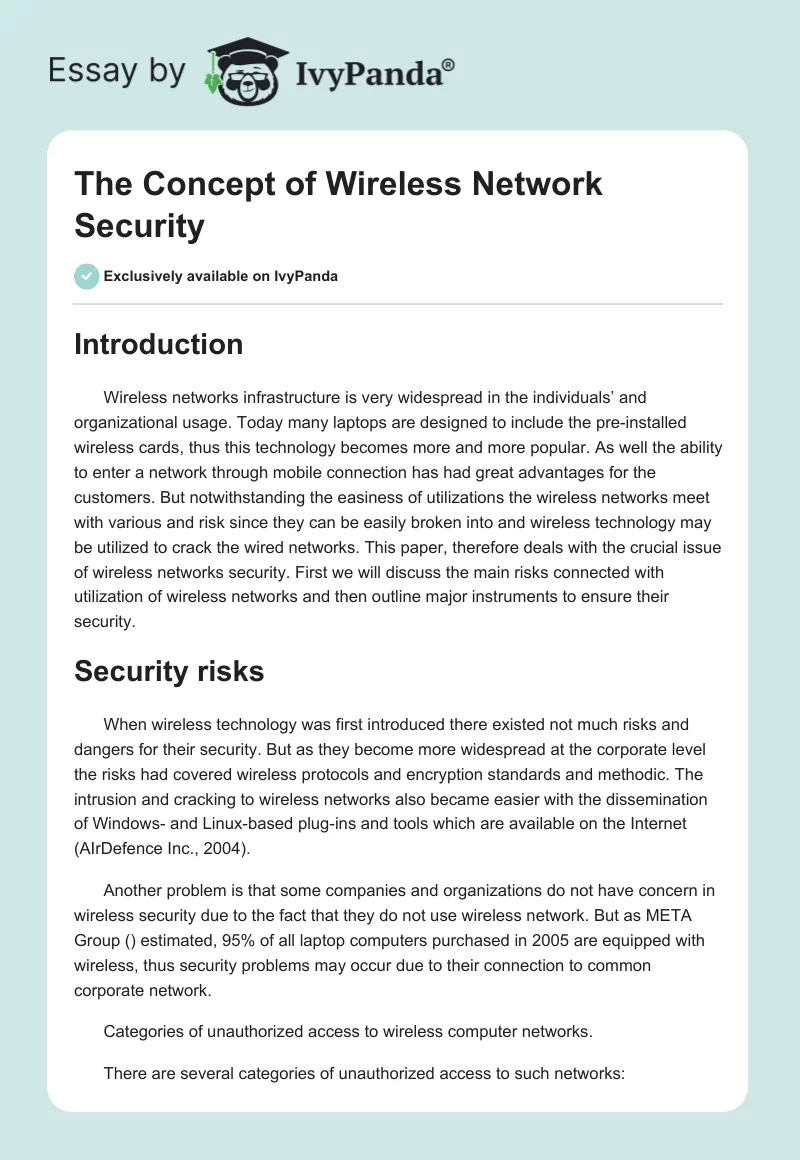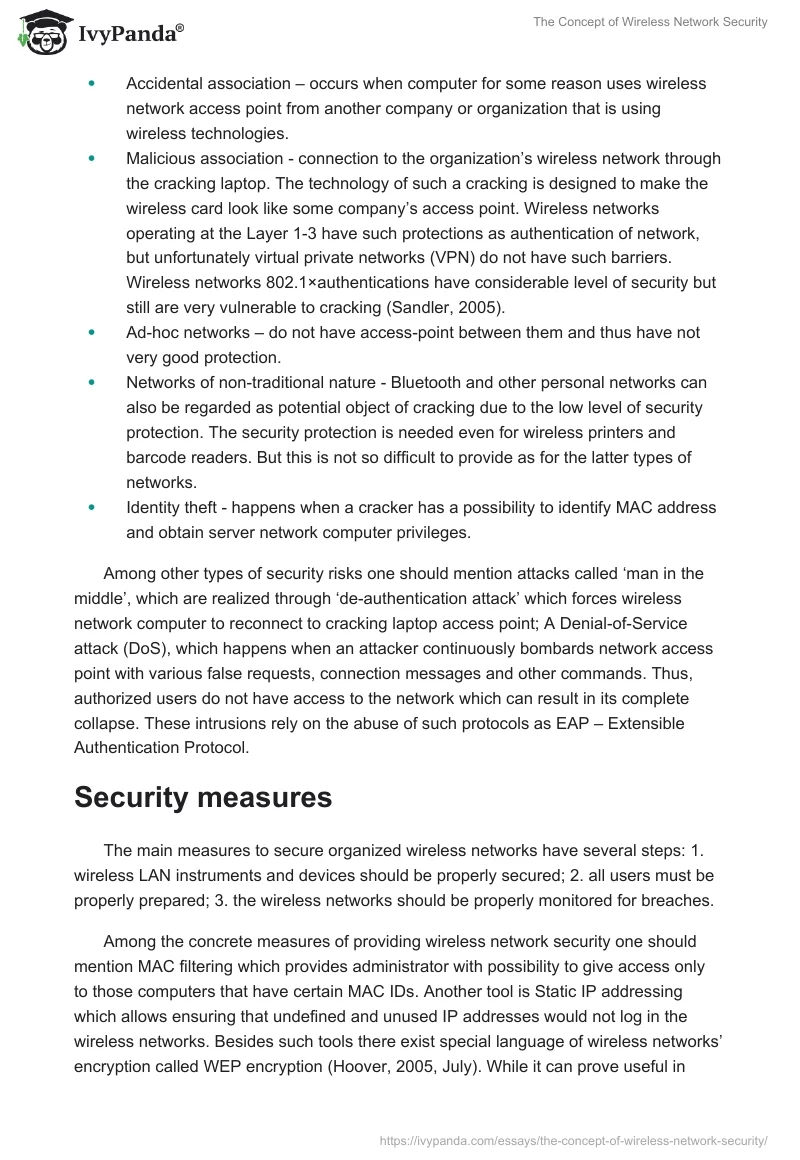Introduction
Wireless networks infrastructure is very widespread in the individuals’ and organizational usage. Today many laptops are designed to include the pre-installed wireless cards, thus this technology becomes more and more popular. As well the ability to enter a network through mobile connection has had great advantages for the customers. But notwithstanding the easiness of utilizations the wireless networks meet with various and risk since they can be easily broken into and wireless technology may be utilized to crack the wired networks. This paper, therefore deals with the crucial issue of wireless networks security. First we will discuss the main risks connected with utilization of wireless networks and then outline major instruments to ensure their security.
Security risks
When wireless technology was first introduced there existed not much risks and dangers for their security. But as they become more widespread at the corporate level the risks had covered wireless protocols and encryption standards and methodic. The intrusion and cracking to wireless networks also became easier with the dissemination of Windows- and Linux-based plug-ins and tools which are available on the Internet (AIrDefence Inc., 2004).
Another problem is that some companies and organizations do not have concern in wireless security due to the fact that they do not use wireless network. But as META Group () estimated, 95% of all laptop computers purchased in 2005 are equipped with wireless, thus security problems may occur due to their connection to common corporate network.
Categories of unauthorized access to wireless computer networks.
There are several categories of unauthorized access to such networks:
- Accidental association – occurs when computer for some reason uses wireless network access point from another company or organization that is using wireless technologies.
- Malicious association – connection to the organization’s wireless network through the cracking laptop. The technology of such a cracking is designed to make the wireless card look like some company’s access point. Wireless networks operating at the Layer 1-3 have such protections as authentication of network, but unfortunately virtual private networks (VPN) do not have such barriers. Wireless networks 802.1×authentications have considerable level of security but still are very vulnerable to cracking (Sandler, 2005).
- Ad-hoc networks – do not have access-point between them and thus have not very good protection.
- Networks of non-traditional nature – Bluetooth and other personal networks can also be regarded as potential object of cracking due to the low level of security protection. The security protection is needed even for wireless printers and barcode readers. But this is not so difficult to provide as for the latter types of networks.
- Identity theft – happens when a cracker has a possibility to identify MAC address and obtain server network computer privileges.
Among other types of security risks one should mention attacks called ‘man in the middle’, which are realized through ‘de-authentication attack’ which forces wireless network computer to reconnect to cracking laptop access point; A Denial-of-Service attack (DoS), which happens when an attacker continuously bombards network access point with various false requests, connection messages and other commands. Thus, authorized users do not have access to the network which can result in its complete collapse. These intrusions rely on the abuse of such protocols as EAP – Extensible Authentication Protocol.
Security measures
The main measures to secure organized wireless networks have several steps: 1. wireless LAN instruments and devices should be properly secured; 2. all users must be properly prepared; 3. the wireless networks should be properly monitored for breaches.
Among the concrete measures of providing wireless network security one should mention MAC filtering which provides administrator with possibility to give access only to those computers that have certain MAC IDs. Another tool is Static IP addressing which allows ensuring that undefined and unused IP addresses would not log in the wireless networks. Besides such tools there exist special language of wireless networks’ encryption called WEP encryption (Hoover, 2005, July). While it can prove useful in some cases there many deficiencies and breaches that can be circumvented by crackers using open source cracker’s software. The drawback of this encryption mechanism were later corrected in WPA (Wi-FI Protected Access), which uses TKIP encryption algorithm and WPA 2 the main advantage of which is the introduction of the AES-CCMP algorithms as a necessary feature, which ensured creation comprehensive wireless networks security mechanism.
Besides this, different security protocols are used for the wireless networks LEAP, PEAP and TKIP which are designed to provide the secure transport of data, encryption keys and various passwords.
Some mechanism such as USB tokens, software tokens and smart cards are used for high security networks, which require highly sophisticated and strict procedures for authorization and authentication.
References
- AIrDefence Inc. (2002-2005). Wireless LAN Security: What Hackers Know That You Don’t A white paper by AirDefense, Inc. AirDefense, Inc.
- Hoover, M. (2005, July). Network Security: The New Perimeter; Security Threats Can No Longer Be Contained in the DMZ. How Do You Protect Every Resource, and Every User’s Traffic, No Matter Where It’s Coming From?. Business Communications Review, 35, 40.
- Sandler, I. (2005). Road Warriors on Trojan Horses: Ensuring End User Compliance Reduces the Cost of Network Security. T H E Journal (Technological Horizons In Education), 33(1), 48.


